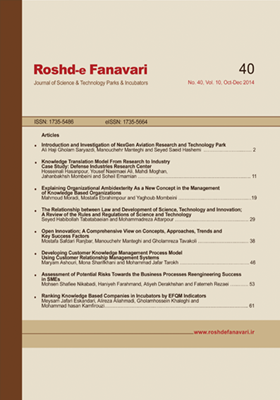-
-
List of Articles
-
Open Access Article
1 - Ranking Knowledge Based Companies in Incubators by EFQM Indicators
Meysam Jafari Eskandari Alireza Ali Ahmadi Gholamhosein Khaleghi Mohammad Hasan Kamfirouzy -
Open Access Article
2 - Knowledge Translation Model From Research to Industry Case Study: Defense Industries Research Center
Yousef Naeimaei Hossein Ali Hasan pour Mahdi Moghan Jahanbakhsh Mambini Soheyl Emamian -
Open Access Article
3 - Developing Customer Knowledge Management Process Model Using Customer Relationship Management Systems
Maryam Ashoori Mona Sharif khani Mohammad Jafar Tarokh -
Open Access Article
4 - Assessment of Potential Risks Towards the Business Processes Reengineering Success in SMEs
Mohsen Shafiei Nik Abadi Haniyeh Farahmand Atiyeh Derakhshan Fatemeh Rezaei -
Open Access Article
5 - Open Innovation; A Comprehensive View on Concepts, Approaches, Trends and Key Success Factors
Mostafa Safdari Ranjbar Manochehr Manteghi Gholamreza Tavakoli -
Open Access Article
6 - A Review of the Rules and Regulations of Science and Technology and Relationship to Innovation
Mohammad reza Ata pour Seyed Habibollah Tabatabaeiyan -
Open Access Article
7 - Explaining Organizational Ambidexterity As a New Concept in the Management of Knowledge Based Organizations
Mahmod Moradi Mostafa Ebrahim pour Azbary Yaughob Mambini -
Open Access Article
8 - Study onthe Role of Government in Improving the Process of Launchingand Development ofKnowledge-based Businesses
-
Open Access Article
9 - The Study on Research and Technology Park Policies and its Effective Factors Case Study: NexGen Aviation Research and Technology Park
Ali Haji Gholam Saryazdi Manochehr Manteghi سید سعید هاشمی
-
The rights to this website are owned by the Raimag Press Management System.
Copyright © 2017-2025







